Analysis of Inequality Levels of Industrial Development in Rural Areas through Inequality Indices and Spatial Autocorrelation
Abstract
1. Introduction
2. Methodology
2.1. Theil Index
2.2. Gini Coefficient
2.3. Spatial Autocorrelation
2.3.1. Global Moran’s I
2.3.2. Anselin Local Moran’s I (ALMI)
2.4. Study Area and Data
2.4.1. Regional Divisions
2.4.2. Data
3. Results and Discussion
3.1. Analysis of the Inequality in Industrial Economic Development Levels of the First-Level Regions
3.1.1. Analysis of Regions with High Inequality in Industrial Economic Development Levels
3.1.2. Analysis of Regions with Middle Inequality in Industrial Economic Development Levels
3.1.3. Analysis of Regions with Low Inequality in Industrial Economic Development Levels
3.2. Analysis of Inequality in Industrial Economic Development Levels among Rural Areas of South Korea
3.3. Spatial Autocorrelation Analysis of Sales and Employment in Rural Areas of South Korea
3.3.1. Global Moran’s I Analysis of Sales and Employment
3.3.2. Anselin Local Moran’s I Analysis of Sales and Employment (ALMI)
4. Conclusions
Author Contributions
Funding
Institutional Review Board Statement
Informed Consent Statement
Data Availability Statement
Conflicts of Interest
References
- Kim, G.S. Analysing the Regional disparity for Balanced regional development: Focusing the case Busan Metropolitan City. Korean Assoc. Local Gov. Stud. 2006, 18, 129–149. [Google Scholar]
- Kim, Y.; Lee, J.-D.; Heshmati, A. Analysis of pay inequality and its impacts on growth and performance in the Korean manufacturing industry. In Proceedings of the KDI-KAEA Conference on Enhancing Productivity and Sustaining Growth 2008, Seoul, Republic of Korea, 8 July 2008; Korea Development Institute: Seoul, Republic of Korea, 2008. [Google Scholar] [CrossRef]
- Lee, J.; Lee, W. A study on the characteristics of disparity between autonomous districts in Seoul. J. Korean Plan. Assoc. 2007, 42, 81–94. [Google Scholar]
- Lee, J. A Study on the Improvement of Under-Developedness Index; Korea Development Institute (KDI): Sejong-si, Republic of Korea, 2013. [Google Scholar]
- Chun, H.J. An Empirical Analysis on the Relationship between Economic Growth and Income Inequality. Seoul Stud. 2014, 15, 95–111. [Google Scholar] [CrossRef]
- Kim, T. The Increasing Income Inequality in Times of COVID-19 and Its Policy Implications. Health Welf. Policy Forum 2020, 290, 20–33. [Google Scholar] [CrossRef]
- Akita, T. Decomposing regional income inequality in China and Indonesia using two-stage nested Theil decomposition method. Ann. Reg. Sci. 2003, 37, 55–77. [Google Scholar] [CrossRef]
- De Maio, F.G. Income inequality measures. J. Epidemiol. Community Health 2007, 61, 849–852. [Google Scholar] [CrossRef] [PubMed]
- Fan, S.; Zhang, X. Infrastructure and regional economic development in rural China. China Econ. Rev. 2004, 15, 203–214. [Google Scholar] [CrossRef]
- Wang, G. MLD index measurement and decomposition of regional income gap in Central China—A case study of Hunan Province. Seeker 2011, 45–47. [Google Scholar] [CrossRef]
- Fei, S. Improvement on the Measure of China’s Urban-Rural Income Gap and its Decomposition. Ph.D. Thesis, Zhejiang University, Zhejiang Province, Hangzhou, China, 2014. [Google Scholar]
- Chen, J.; Dai, D.; Pu, M.; Hou, W.; Feng, Q. The Trend of the Gini Coefficient of China; BWPI Working Paper 109; Brooks World Poverty Institute (BWPI), The University of Manchester: Manchester, UK, 2010. [Google Scholar] [CrossRef]
- Jian, J.; Jianxiang, W.; Xiaoyi, M.; Yuding, W.; Renyong, L. Equality of medical health resource allocation in China based on the Gini coefficient method. Iran. J. Public Health 2015, 44, 445. [Google Scholar]
- Chongvilaivan, A.; Kim, J. Individual income inequality and its drivers in Indonesia: A Theil decomposition reassessment. Soc. Indic. Res. 2016, 126, 79–98. [Google Scholar] [CrossRef]
- Lee, S.-H.; Taniguchi, M.; Masuhara, N.; Mohtar, R.H.; Yoo, S.-H.; Haraguchi, M. Analysis of industrial water–energy–labor nexus zones for economic and resource-based impact assessment. Resour. Conserv. Recycl. 2021, 169, 105483. [Google Scholar] [CrossRef]
- Li, F.; Zhou, C. Spatial autocorrelation analysis on regional economic disparity of northeast economic region in China. Chin. J. Popul. Resour. Environ. 2009, 7, 27–31. [Google Scholar] [CrossRef]
- Tran, T.Q.; Nguyen, C.V.; Van Vu, H. Does economic inequality affect the quality of life of older people in rural Vietnam? J. Happiness Stud. 2018, 19, 781–799. [Google Scholar] [CrossRef]
- Ryser, L.; Halseth, G. Rural economic development: A review of the literature from industrialized economies. Geogr. Compass 2010, 4, 510–531. [Google Scholar] [CrossRef]
- Gardner, B.L. Causes of rural economic development. Agric. Econ. 2005, 32, 21–41. [Google Scholar] [CrossRef]
- Rodríguez-Pose, A.; Hardy, D. Addressing poverty and inequality in the rural economy from a global perspective. Appl. Geogr. 2015, 61, 11–23. [Google Scholar] [CrossRef]
- Terluin, I.J. Differences in economic development in rural regions of advanced countries: An overview and critical analysis of theories. J. Rural Stud. 2003, 19, 327–344. [Google Scholar] [CrossRef]
- Theil, H. Economics and Information Theory; North-Holland Publishing Company: Amsterdam, The Netherlands, 1967. [Google Scholar]
- Gini, C. Variabilità e mutabilità: Contributo allo studio delle distribuzioni e relazioni statistiche. Studi Econ.-Giuridici dell’Univ. Cagliari 1912, 3, 1–158. [Google Scholar]
- Anselin, L. Local indicators of spatial association—LISA. Geogr. Anal. 1995, 27, 93–115. [Google Scholar] [CrossRef]
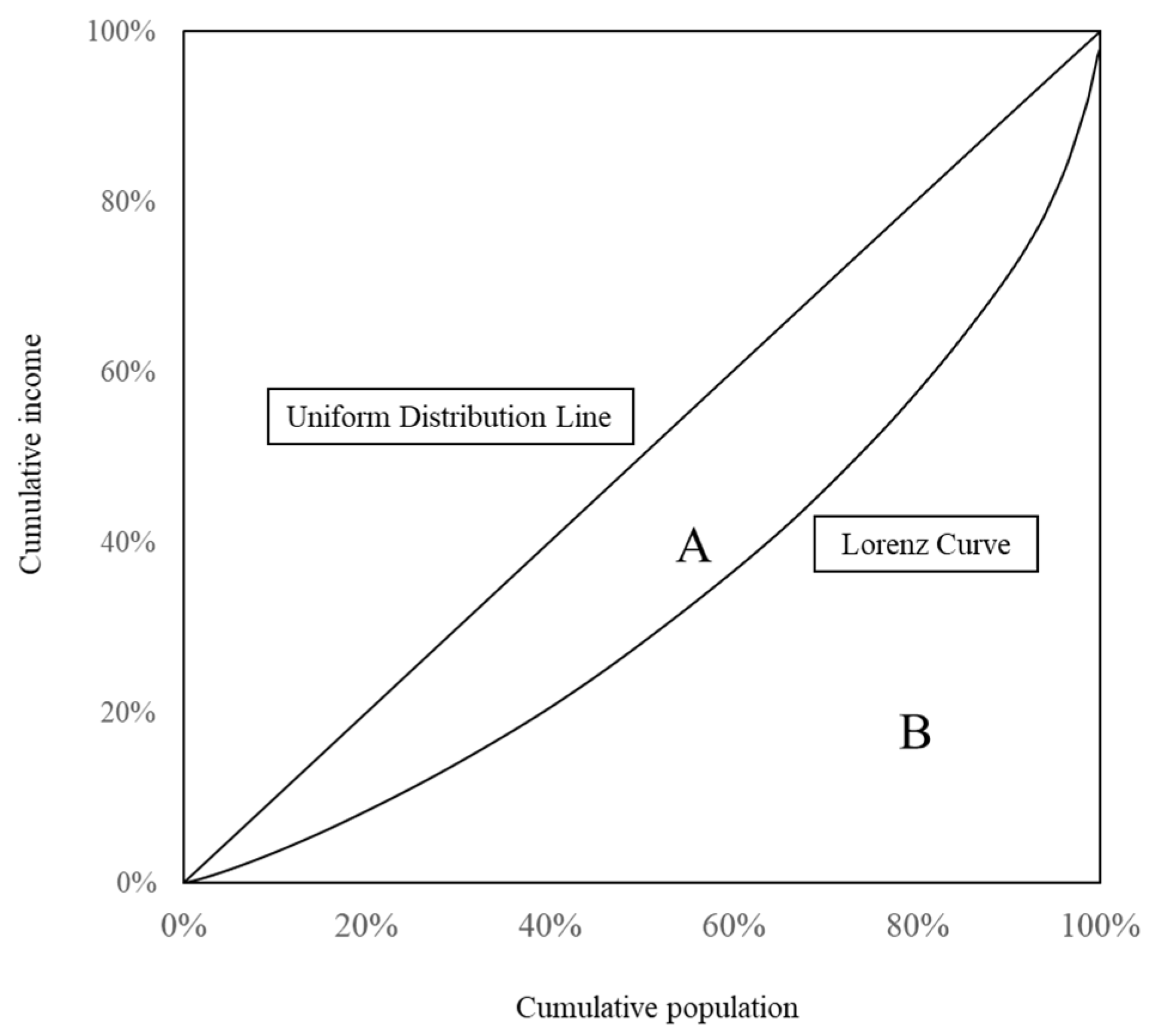
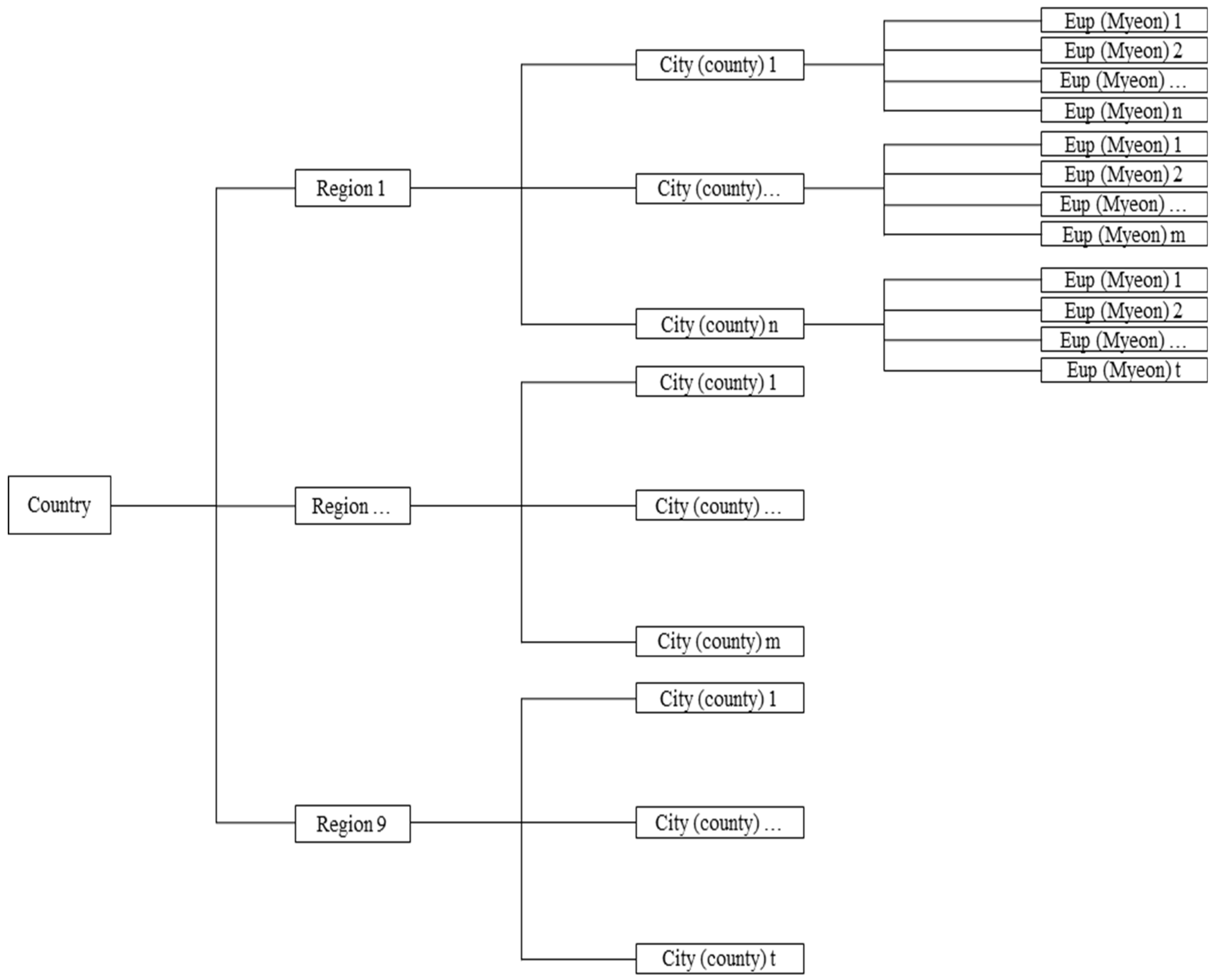
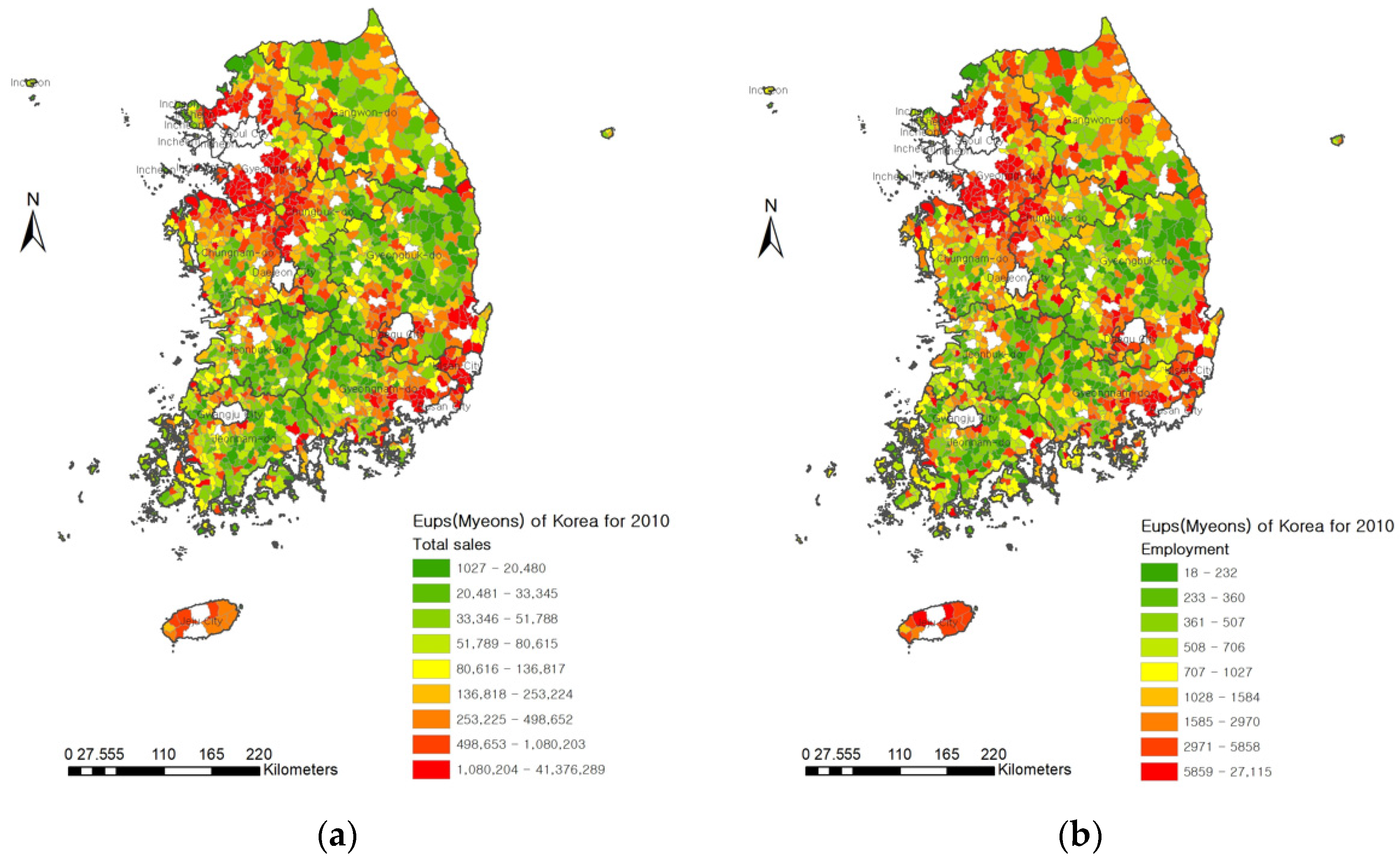
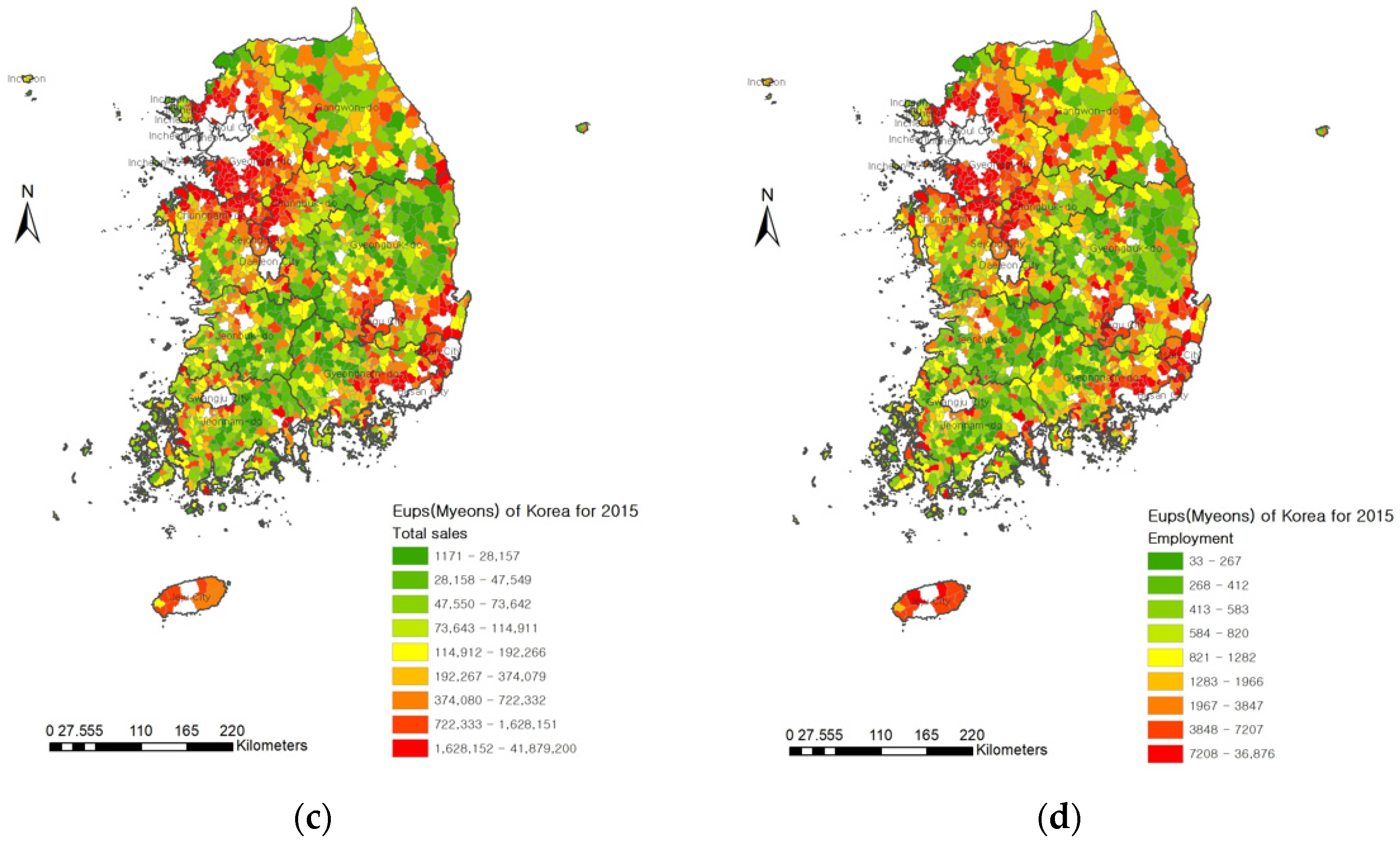
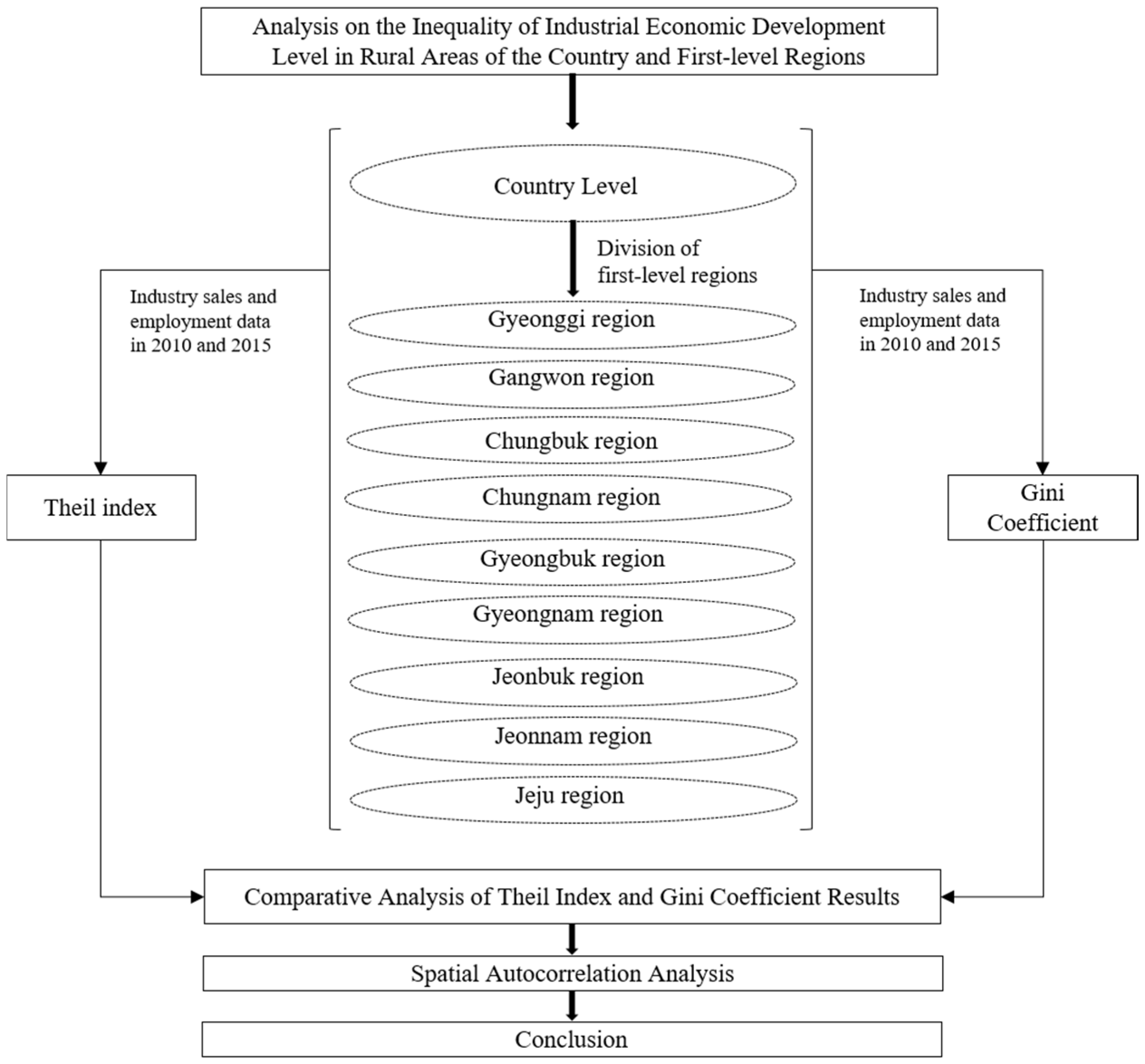
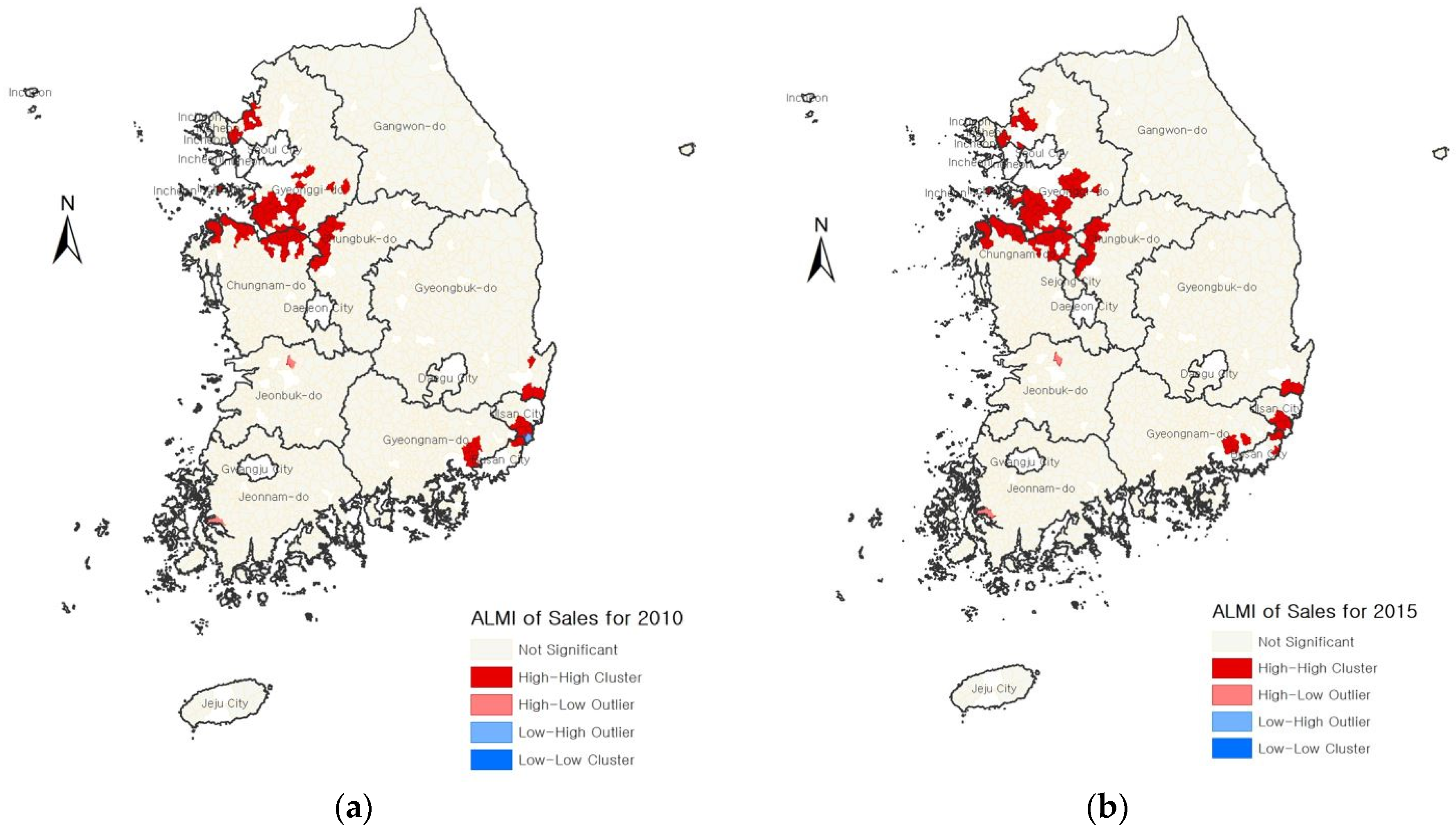
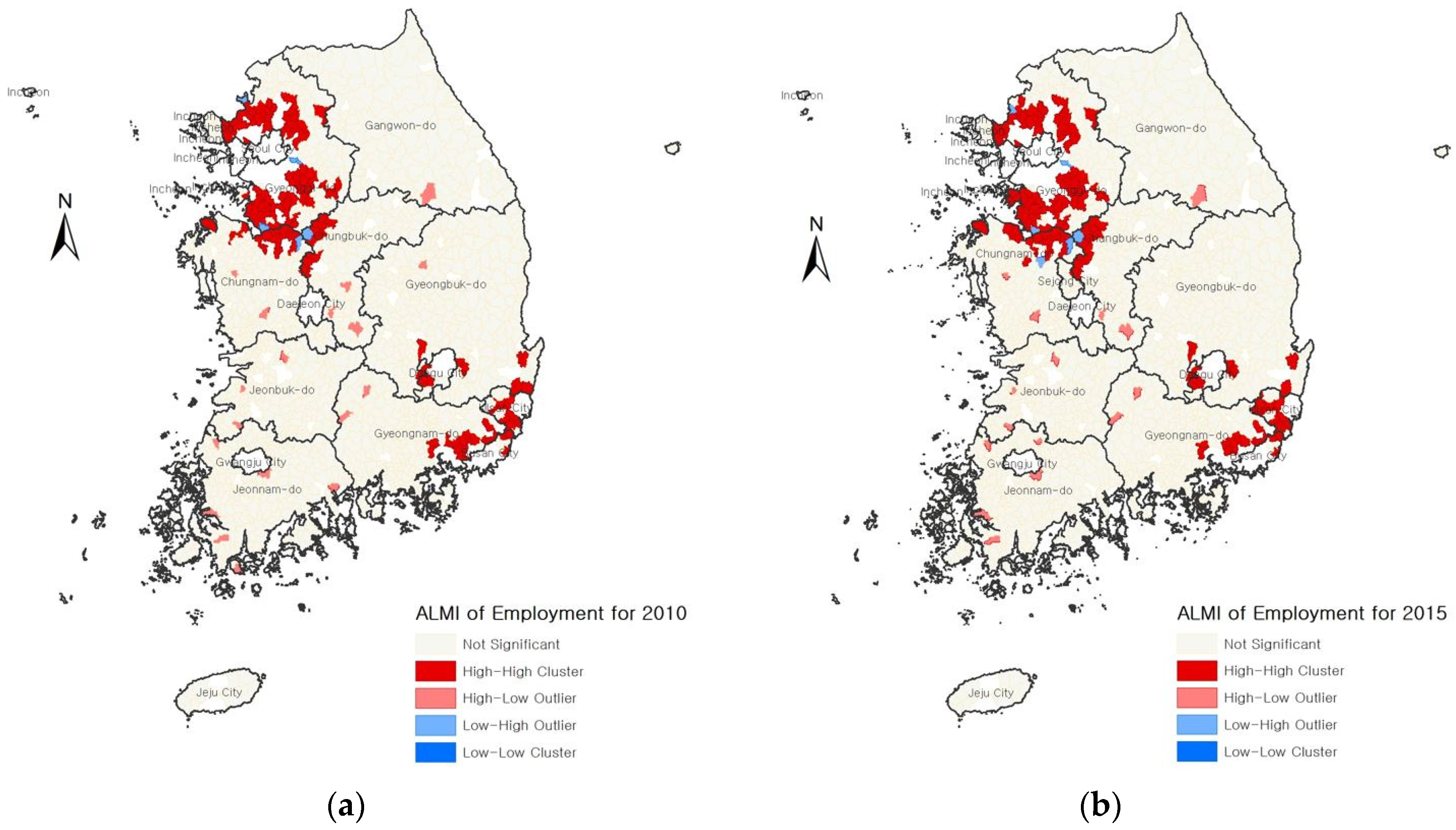
| Researcher | Research Content | Research Methods | Indicator Selection |
|---|---|---|---|
| Kim G.S. (2006) [1]. | Analysis of the disparity among districts in Busan Metropolitan City in terms of population, education, social welfare, culture, transportation, industrial economy, and living environment. |
| Indicators used in the industrial economy part:
|
| Kim Y. et al. (2008) [2]. | Analysis of pay inequality in manufacturing in South Korea. | Theil-T index | Income and number of employees |
| Lee J. and Lee W. (2007) [3]. | Study on the characteristics of disparity between autonomous districts in Seoul. | Factor analysis and cluster analysis | Indicators used in the economy part:
|
| Lee J. (2013) [4]. | Analysis of the inequality of level of under-development. |
| Indicators used in the economy part:
|
| Chun (2014) [5]. | Analysis of the relationship between economic growth and income inequality. |
| Income and population |
| Akita (2003) [7]. | Analysis of decomposing regional income inequality in China and Indonesia. |
| GDP and population |
| Wang (2011) [10]. | Analysis of the urban-rural income gap in Hunan Province. | Theil-L index (GE(0)) | GDP, income, andpopulation |
| Fei (2014) [11]. | Analysis of the urban-rural income gap in China. | Theil index | Income and population |
| Chen et al. (2010) [12]. | Analysis of Gini coefficient trend in China. | Gini coefficient | Income and population |
| Jin et al. (2015) [13]. | Analysis of equality of medical health resource allocation in China. | Gini coefficient |
|
| Chongvilaivan et al. (2016) [14]. | Analysis of individual income inequality and its drivers in Indonesia. | Theil decomposition method | Income and number of individuals |
| Lee S.-H. et al. (2021) [15]. | Analysis of economic inequality among prefectures in Japan. | Gini coefficient | Gross regional products and number of prefectures. |
| Tran et al. (2018) [17]. | Analysis of the influence of economic inequality on quality of life of the rural elderly. |
| Household consumption expenditure and population |
| Li and Zhou (2009) [16]. | Spatial Autocorrelation Analysis on Regional Economic Disparity of Northeast Economic Region in China |
| GDP per capita |
| Region | Composition | Number of Eups and Myeons |
|---|---|---|
| Gyeonggi | Seoul, Incheon Metropolitan City, and Gyeonggi-do | Seoul: 0, Incheon: 20, Gyeonggi-do: 140, 160 in total. |
| Gangwon | Gangwon-do | Gangwon-do: 114, 114 in total. |
| Chungbuk | Chungcheongbuk-do | Chungcheongbuk-do: 102, 102 in total. |
| Chungnam | Daejeon Metropolitan City, Sejong Special Self-governing City, and Chungcheongnam-do | Daejeon: 0, Sejong: 10, Chungcheongnam-do: 161, 171 in total. |
| Gyeongbuk | Daegu Metropolitan City, Gyeongsangbuk-do | Daegu: 9, Gyeongsangbuk-do: 238, 247 in total. |
| Gyeongnam | Ulsan Metropolitan City, Busan Metropolitan City, and Gyeongsangnam-do | Ulsan: 12, Busan: 5, Gyeongsangnam-do: 196, 213 in total. |
| Jeonbuk | Jeollabuk-do | Jeollabuk-do: 159, 159 in total. |
| Jeonnam | Gwangju Metropolitan City, Jeollanam-do | Gwangju: 0, Jeollanam-do: 229, 229 in total. |
| Jeju | Jeju | Jeju: 12, 12 in total. |
| 2010 | 2015 | |||
|---|---|---|---|---|
| Number of Employees | Industrial Sales (Million Won) | Number of Employees | Industrial Sales (Million Won) | |
| Minimum | 18 | 1027 | 33 | 1171 |
| Maximum | 27,115 | 41,376,289 | 36,876 | 41,879,200 |
| Mean | 2323 | 577,343 | 2955 | 766,996 |
| Median | 831 | 102,198 | 1010 | 148,406 |
| Standard deviation | 3740 | 2,032,371 | 4872 | 2,269,497 |
| Sample size | 1408 | 1408 | 1407 | 1407 |
| Region | Year | TWC | TBC | TR | Within-City Component (% Contribution) | Between-City Component (% Contribution) | GINI |
|---|---|---|---|---|---|---|---|
| Chungnam | 2010 | 0.091 | 0.101 | 0.191 | 47.35% | 52.65% | 0.513 |
| 2015 | 0.054 | 0.065 | 0.119 | 45.59% | 54.41% | 0.409 | |
| Gyeongnam | 2010 | 0.069 | 0.073 | 0.143 | 48.61% | 51.39% | 0.438 |
| 2015 | 0.046 | 0.045 | 0.090 | 50.61% | 49.39% | 0.364 |
| Region | Year | TWC | TBC | TR | Within-City Component (% Contribution) | Between-City Component (% Contribution) | GINI |
|---|---|---|---|---|---|---|---|
| Gyeonggi | 2010 | 0.034 | 0.038 | 0.072 | 47.03% | 52.97% | 0.319 |
| 2015 | 0.028 | 0.030 | 0.058 | 48.13% | 51.87% | 0.284 | |
| Chungbuk | 2010 | 0.037 | 0.029 | 0.066 | 55.79% | 44.21% | 0.301 |
| 2015 | 0.037 | 0.019 | 0.056 | 66.54% | 33.46% | 0.286 | |
| Gyeongbuk | 2010 | 0.047 | 0.018 | 0.065 | 72.67% | 27.33% | 0.305 |
| 2015 | 0.030 | 0.011 | 0.041 | 72.74% | 27.26% | 0.241 | |
| Jeonbuk | 2010 | 0.055 | 0.036 | 0.091 | 60.33% | 39.67% | 0.354 |
| 2015 | 0.038 | 0.018 | 0.056 | 68.43% | 31.57% | 0.281 | |
| Jeonnam | 2010 | 0.043 | 0.036 | 0.080 | 54.34% | 45.66% | 0.333 |
| 2015 | 0.023 | 0.014 | 0.038 | 62.30% | 37.70% | 0.232 |
| Region | Year | TWC | TBC | TR | Within-City Component (% Contribution) | Between-City Component (% Contribution) | GINI |
|---|---|---|---|---|---|---|---|
| Gangwon | 2010 | 0.026 | 0.014 | 0.040 | 63.95% | 36.05% | 0.236 |
| 2015 | 0.034 | 0.017 | 0.051 | 67.30% | 32.70% | 0.266 | |
| Jeju | 2010 | 0.018 | 0.00001 | 0.018 | 99.89% | 0.11% | 0.148 |
| 2015 | 0.009 | 0.00002 | 0.009 | 99.94% | 0.06% | 0.111 |
| Year | Theil-L | GINI |
|---|---|---|
| 2010 | 0.019 | 0.401 |
| 2015 | 0.013 | 0.334 |
| Attribute | Year | Moran’s I |
|---|---|---|
| Sales | 2010 | 0.136 |
| 2015 | 0.201 | |
| Employment | 2010 | 0.310 |
| 2015 | 0.346 |
Disclaimer/Publisher’s Note: The statements, opinions and data contained in all publications are solely those of the individual author(s) and contributor(s) and not of MDPI and/or the editor(s). MDPI and/or the editor(s) disclaim responsibility for any injury to people or property resulting from any ideas, methods, instructions or products referred to in the content. |
© 2023 by the authors. Licensee MDPI, Basel, Switzerland. This article is an open access article distributed under the terms and conditions of the Creative Commons Attribution (CC BY) license (https://creativecommons.org/licenses/by/4.0/).
Share and Cite
Qu, R.; Lee, S.-H.; Rhee, Z.; Bae, S.-j. Analysis of Inequality Levels of Industrial Development in Rural Areas through Inequality Indices and Spatial Autocorrelation. Sustainability 2023, 15, 8102. https://doi.org/10.3390/su15108102
Qu R, Lee S-H, Rhee Z, Bae S-j. Analysis of Inequality Levels of Industrial Development in Rural Areas through Inequality Indices and Spatial Autocorrelation. Sustainability. 2023; 15(10):8102. https://doi.org/10.3390/su15108102
Chicago/Turabian StyleQu, Rui, Sang-Hyun Lee, Zaewoong Rhee, and Seung-jong Bae. 2023. "Analysis of Inequality Levels of Industrial Development in Rural Areas through Inequality Indices and Spatial Autocorrelation" Sustainability 15, no. 10: 8102. https://doi.org/10.3390/su15108102
APA StyleQu, R., Lee, S.-H., Rhee, Z., & Bae, S.-j. (2023). Analysis of Inequality Levels of Industrial Development in Rural Areas through Inequality Indices and Spatial Autocorrelation. Sustainability, 15(10), 8102. https://doi.org/10.3390/su15108102






